Physical Address
304 North Cardinal St.
Dorchester Center, MA 02124
Parasitic worms are found worldwide, but intestinal colonization by helminths is most common in less industrialized, developing countries. Modern travel, emigration, and consumption of “exotic” cuisines allow intestinal helminths to appear in any locale. People now acquire tropical helminths without leaving their industrialized temperate cities. Because intestinal helminth infections are more frequent in developing countries, complete travel history is a critical—but often overlooked—aspect of the patient interview. Helminths may survive for decades within a host, so even a remote history of visits to or emigration from countries where helminths are endemic is important. Fresh food is flown around the world and often consumed raw, often at a great distance from its original point of origin.
Physicians need to remain alert to the possibility of infection with these organisms because some cause severe disease that requires years to develop or occurs only under special circumstances. For example, patients might have occult Strongyloides stercoralis until treatment with glucocorticoids causes fulminant disease, occult Clonorchis sinensis until they develop cholangiocarcinoma, or occult Schistosoma mansoni until they develop portal hypertension and bleeding from esophageal varices.
In developed countries, intestinal helminths often are identified as an unexpected finding rather than as a result of an actively pursued diagnostic evaluation. Helminths are complex organisms well-adapted to their hosts; like quiet house guests, most cause no symptoms. Worms rarely cause diarrhea, but many medical laboratories do not assay formed stool routinely for parasite eggs. Physicians need to communicate their concerns of possible helminthic infection to laboratory personnel. A telephone call to the local laboratory before a sample is sent can improve diagnostic results dramatically. Occasionally, alarmed patients bring proglottids or whole worms that they passed with their stools. These specimens should be fixed in 5% aqueous formalin and sent for identification. All specimens should be handled carefully with full precautions to avoid accidental exposure.
Some helminthic infections are difficult to diagnose, especially when the worm burden is light. Diagnosis can require serologic evaluation, analysis of multiple stools, use of stool concentration techniques, or amplification of helminth DNA (molecular studies) in addition to a high level of physician awareness. For example, S. stercoralis eggs do not appear in the stool, and diagnosis is best made serologically. Ancylostoma caninum causes eosinophilic enteritis but does not lay eggs when infecting people.
Some helminths can cause severe disease, but this is unusual. Most persons colonized with helminths have no symptoms or illness attributable to the parasites. Only with heavy or protracted infections does disease result. Well-adapted worms usually act more as commensals than as pathogens. It is even possible that exposure to helminths affords some protection against disease due to robust immune reactions. Helminths induce immune regulatory pathways. Studies in mice and rats show that exposure to helminths can be used to prevent or treat colitis, insulin-dependent diabetes mellitus, and auto-immune encephalitis. Studies in humans show that helminth exposure may improve UC, reduce the risk of Crohn disease, and that helminth eradication increases atopy and worsens the course of multiple sclerosis. Although it remains important to treat helminthic infections when they are discovered, further research on these organisms may enable discovery of new approaches to treat immune-mediated disease.
Helminth associated protection from pathogenic inflammation may be mediated, at least in part, by changes in the microbiome. Helminth infection alters the composition of the microbiota and promotes richness and strain diversity of intestinal commensals. Several potential mechanisms have been proposed to explain how helminths alter the composition of microbiota. Bacterial attachment (a key trigger of colitis) was reduced after Trichuris exposure. Another study that focused on mice deficient for Crohn disease associated CARD15/Nod2, found that helminth exposure inhibits intestinal colonization by inflammatory Bacteroides species, but promotes the establishment of protective microbiota enriched for Clostridiales . The microbiome influences host metabolism and helminth infection also can alter host metabolic responses. Australian Aboriginal adults with S. stercoralis infection are protected from type 2 diabetes. Soil-transmitted helminth infection was found to increase insulin sensitivity modestly in a cross-sectional study of Indonesians. Some of this effect could be due to helminthic modulation of the microbiome as discussed earlier. In addition, helminth products also can directly influence cell responses in animal models of metabolic syndrome.
This chapter is divided into 3 sections: nematodes (roundworms), cestodes (tapeworms), and trematodes (flukes or flatworms). For the most part, each worm is addressed separately, noting its epidemiology, life cycle, clinical manifestations, diagnosis, and treatment.
A. lumbricoides is the largest of the nematode parasites that colonize humans; females can grow to 49 cm (19 inches). The name “lumbricoides” alludes to its resemblance to earth worms ( Lumbricus sp.). The parasite is acquired by ingesting its eggs. Ascaris can cause intestinal obstruction and pancreaticobiliary symptoms. Treatment is albendazole.
A. lumbricoides has a worldwide distribution, although these parasites are most numerous in less-developed countries and in areas with poor sanitation. About 1.2 billion people (25% of the world’s population) harbor A. lumbricoides and 5.2 billion people are at risk of becoming infected. Children acquire the parasite by playing in dirt contaminated with its eggs, whereas adults most often are infected by farming or eating raw vegetables from plants fertilized with untreated sewage. Pigs harbor A. suum, which is very closely related to A. lumbricoides ; zoonotic infections occur but are unusual.
Humans acquire the parasite by ingesting embryonated eggs that contain third-stage larvae. Fertilized eggs are passed in stool and incubate in the soil for 10 to 15 days while the embryo develops and molts twice, after which the eggs become infective. The eggs are remarkably stable, can survive freezing, and can remain viable for 7 to 10 years. The eggs are resistant to most chemical treatments including pickling, but they rapidly die in boiling water. Once ingested, eggs hatch in the duodenum and release their larvae, which penetrate the intestinal wall and enter the mesenteric venules and lymphatics. Larvae that migrate with portal blood pass to the liver, through the sinusoids to the hepatic veins, and then through the right side of the heart to enter the lungs. Larvae migrating via the lymphatics pass through mesenteric lymph nodes to the thoracic duct and enter the superior vena cava, also to arrive in the lungs. The larvae then lodge in the pulmonary capillaries and break into the alveoli, where they molt twice while growing to 1.5 mm in length. Larvae then ascend the tracheobronchial tree, arrive in the hypopharynx, are again swallowed, and pass into the small intestine, where they molt again and finally mature.
Mature male A. lumbricoides are smaller (10 to 30 cm) than females (20 to 49 cm). Worms mate in the small intestine and females deposit about 200,000 eggs a day. Adult worms live for about 1 year (6 to 18 months). Because their eggs require incubation in the soil to become infective, Ascaris does not multiply in the host. Continued infestation requires repeat ingestion of embryonated eggs.
A. lumbricoides produces no symptoms in most infected persons. Often, worms are found unexpectedly on endoscopy ( ) or are seen on radiologic imaging, or eggs are identified in stool specimens of patients with symptoms not directly attributable to the worms. Disease usually develops only in those with heavy worm burdens: pulmonary, intestinal, and hepatobiliary ascariasis are well-described. Pulmonary ascariasis ( Ascaris pneumonitis) develops 4 to 16 days after ingesting infective eggs. The larvae migrate into the alveoli and elicit an inflammatory response that can cause cough and fleeting eosinophilic infiltrate (Löffler syndrome). The pneumonitis usually is self-limited but can be life-threatening if larvae are numerous.
Large numbers of mature worms can cause severe intestinal symptoms including abdominal pain, distention, nausea, and vomiting. The most common complication of intestinal ascariasis is partial or complete SBO; such patients often have a history of passing mature worms in their stool or vomitus. Patients with SBO generally have more than 60 worms, and the rare patients with fatal disease often have more than 600 worms. Fatality results from intestinal necrosis caused by obstruction, intussusception, or volvulus ( Fig. 114.1 ). Most cases of SBO, absent signs of peritonitis or perforation, can be managed conservatively.
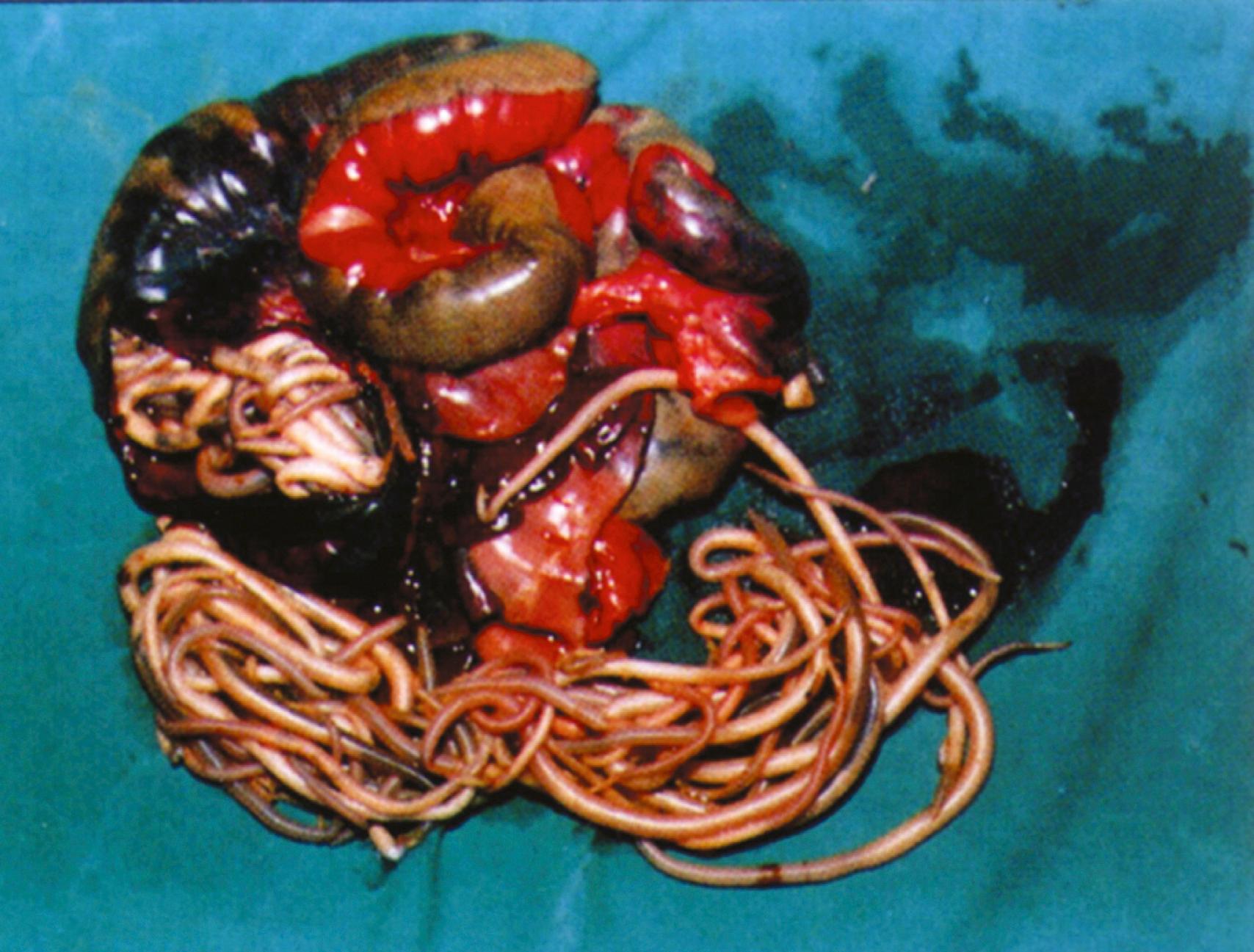
A. lumbricoides is highly motile. Mature worms can enter the ampulla of Vater ( Fig. 114.2 ) and migrate into the bile or pancreatic ducts, causing biliary colic, obstructive jaundice, ascending cholangitis, acalculous cholecystitis, or acute pancreatitis. Pregnancy can promote biliary migration. Ascaris worms can move in and out of the papilla, producing intermittent symptoms and fluctuating laboratory tests. Recurrent ascending cholangitis or acute pancreatitis from ascariasis is rare in highly developed Western countries, but must be considered in patients who have recently visited endemic areas and can be fatal if the diagnosis is not entertained and treatment is delayed.
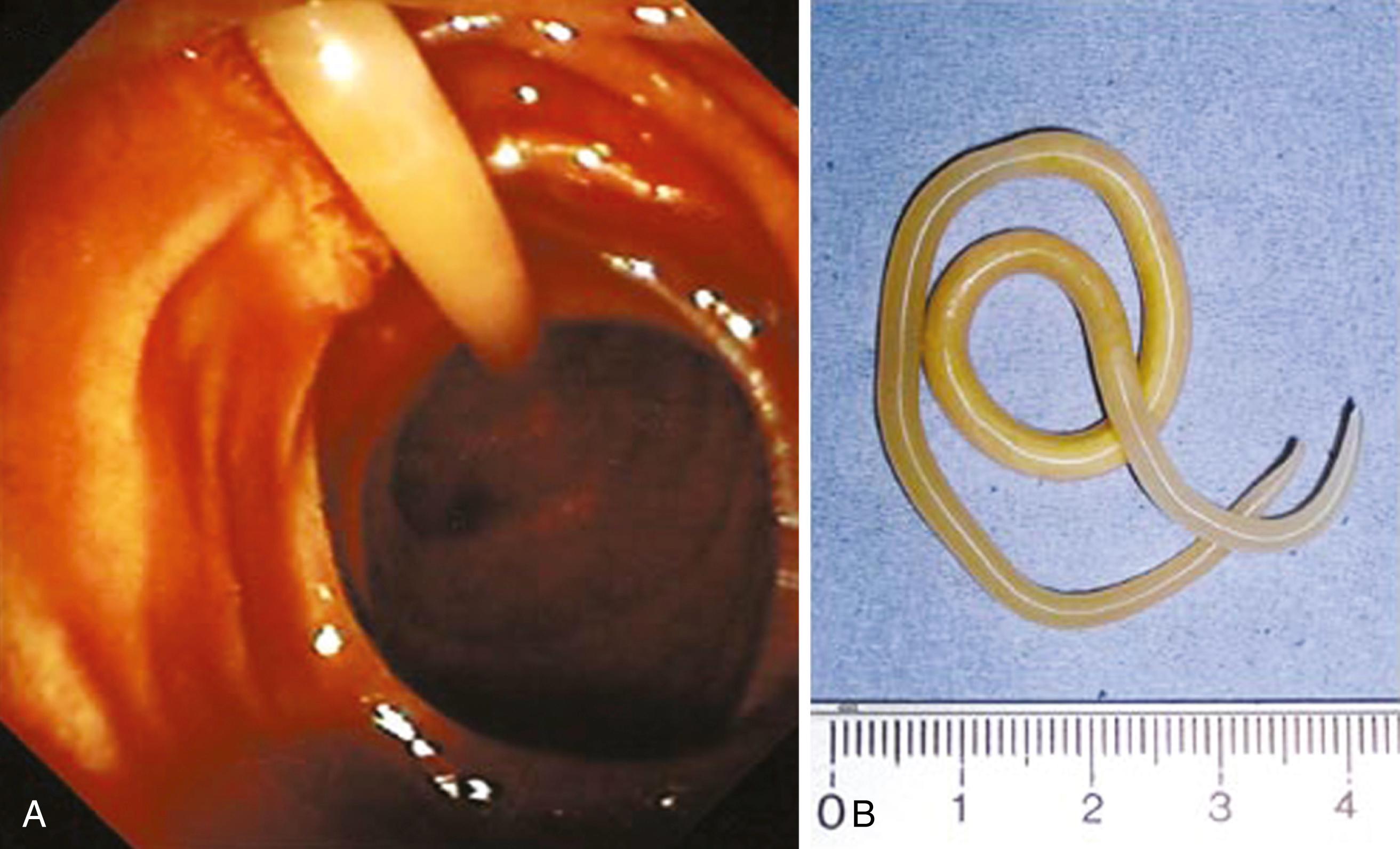
Often it is an alarmed patient who discovers Ascaris after passing a motile adult worm with a bowel movement. The worms, however, usually do not cause diarrhea. Most patients do not have specific symptoms or eosinophilia. Ascaris eggs are visible in direct smears of stool ( Fig. 114.3 ). Eggs begin to appear in the stool about 2 months after initial exposure. Fertilized eggs are 35 by 55 μm and have a thick shell and outer layer; females also lay unfertilized eggs that are larger (90 by 44 μm) and have a thin shell and outer layer. Ascaris eggs that lose their outer layer resemble the eggs of hookworms. Adult worms may be seen at endoscopy, or identified on UGIS as long, linear, filling defects within the small intestine. The worms retain barium after it has cleared from the patient’s GI tract, producing isolated linear opacities. Similar findings are seen on ERCP if a worm is within the bile or pancreatic duct ( Fig. 114.4 ). Ascaris also has a characteristic appearance on US examination of the bile duct or pancreas, appearing as long, linear echogenic stripes that do not cast acoustic shadows.
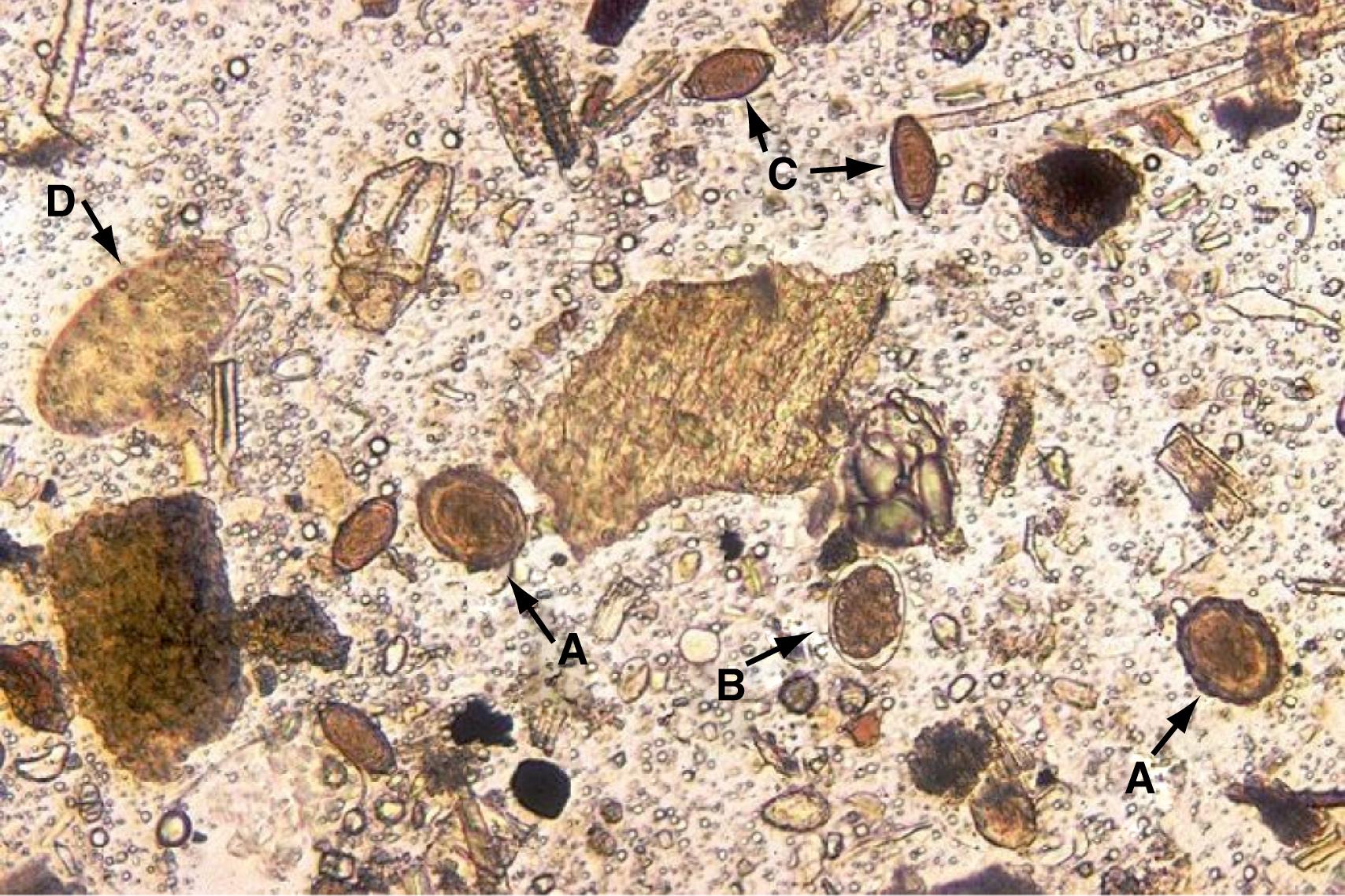
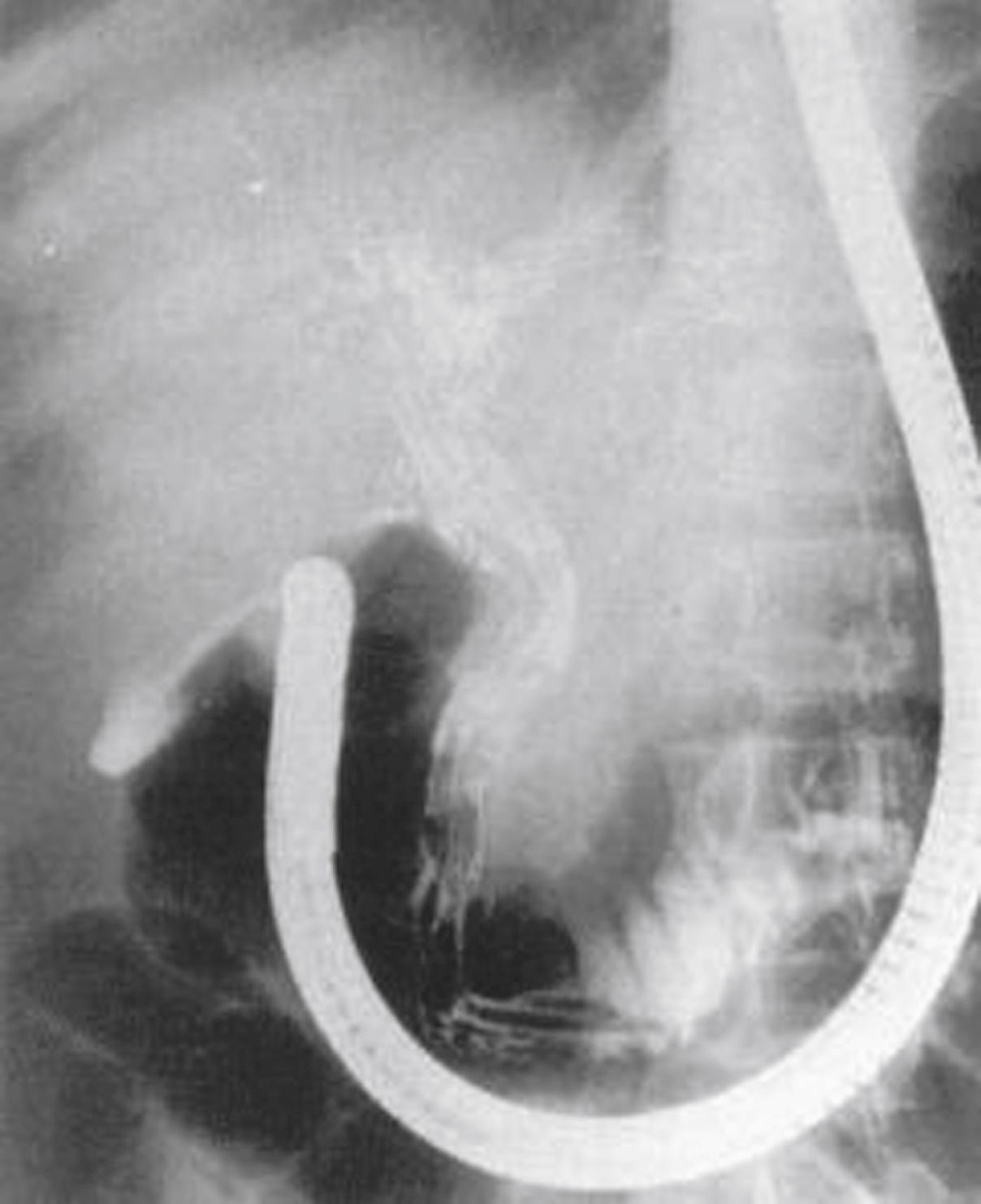
Asymptomatic colonization with A. lumbricoides is treated easily with a single 400-mg oral dose of albendazole. Albendazole inhibits glucose uptake and microtubule formation, effectively paralyzing the worms. Albendazole is poorly absorbed but is still considered possibly teratogenic, and when possible, treatment with this agent should be delayed until after delivery. Previously, clinicians who work in endemic countries would avoid treatment of pregnant women, however, in areas where repeated pregnancy is common, this resulted in prolonged avoidance of potentially life-saving therapy. A recent study of 1257 women treated with albendazole showed no adverse effect of albendazole treatment on birth weight, perinatal mortality, or congenital anomaly compared with placebo. Single-dose mebendazole also is efficacious for Ascaris . A study of 1042 pregnant women in Peru found no adverse effect of a single 500-mg oral dose of mebendazole on birth outcomes.
Patients with pulmonary ascariasis should be treated with glucocorticoids to reduce the pneumonitis and be given 2 400-mg doses of albendazole one month apart. Because albendazole is poorly absorbed, ascaricidal tissue concentrations are not achieved. The first dose kills mature worms that have finished their migration to the intestine, and the second dose kills worms that were in transit when the first dose was given. Albendazole is well tolerated, but can cause nausea, vomiting, and abdominal pain.
Intestinal ascariasis with obstruction often can be treated conservatively with fluid resuscitation, NG decompression, antibiotics, and one dose of albendazole. Surgery is not required unless the patient develops signs of volvulus, intussusception, or peritonitis. If the bowel is viable, an enterotomy allows intraoperative removal of worms. Albendazole may be held until after the obstruction has resolved and then is used to eradicate any remaining organisms.
Hepatobiliary ascariasis also can be treated conservatively with fluid resuscitation, bowel rest, and antibiotics. Worms in the bile duct are not effectively treated with albendazole because the drug is poorly absorbed and not concentrated in bile. This feature of albendazole is advantageous because were paralyzed worms within the duct unable to pass out through the sphincter of Oddi, they could become trapped in the bile duct. Patients with hepatobiliary ascariasis should be treated with albendazole each day for several days because the worms only become susceptible to the drug after they migrate out of the bile duct.
Worms also can invade the pancreatic duct and intrapancreatic Ascaris can be treated just as hepatobiliary ascariasis. Ascending cholangitis, acute obstructive jaundice, or acute pancreatitis requires emergent ERCP with worm extraction from the ducts by balloon, basket, or forceps—preferably without sphincterotomy. Ampullary sphincterotomy permits worms easier access to the ducts and can increase the risk of recurrent pancreaticobiliary ascariasis.
S. stercoralis is a free-living tropical and semitropical soil helminth, the filariform larvae of which can penetrate intact skin. As a parasite, Strongyloides lives in the intestine and lays eggs that hatch while still in the intestine. Filariform larvae develop within the intestine, migrate along defined paths, and mature to increase the number of adult parasites in the host; this results in prolonged infection that may extend to 75 years, after one leaves an endemic area. Immunosuppression and glucocorticoid treatment cause fulminant disease due to enhanced reproduction of parasites that can prove fatal. Treatment is ivermectin.
S. stercoralis is endemic in tropical and semitropical regions, but it also can be acquired in rural southern USA and northern Italy. Strongyloides can exist as a free-living organism that does not require a host to replicate. Patients from endemic areas, military veterans who served in Asia, and prisoners of war are at high risk for subclinical strongyloidiasis. S. fuelleborni fuelleborni (endemic in Africa and Thailand) and S. fuelleborni kelleyi (endemic in Papua New Guinea) also can cause human infections.
Adult male and female S. stercoralis live in the soil and lay eggs that hatch rhabditiform larvae. Rhabditiform larvae develop in the soil into mature adults to complete the life cycle of this worm. Rhabditiform larvae (250 μm) also can develop into longer (500 μm) infective filariform larvae that can penetrate any area of skin that contacts soil, after which they migrate through the dermis to enter the cutaneous vasculature. The larvae circulate with the venous blood until they reach the lungs, where they break into the alveoli and ascend the bronchial tree. The worms then are swallowed with bronchial secretions and pass into the small intestine, where they embed in the jejunal mucosa and mature. Female S. stercoralis can lay fertile eggs by parthenogenesis and, therefore, do not require males to reproduce. The eggs hatch within the small intestine, and rhabditiform larvae migrate into the lumen. Rhabditiform larvae, not eggs, are passed in the stool. A critical feature of S. stercoralis infestation is that some rhabditiform larvae sporadically develop into infective filariform larvae within the intestine. Filariform larvae are able to re-infect (auto-infect) the patient, thereby increasing the parasite burden and permitting prolonged colonization so that subclinical strongyloidiasis can exist for many decades after the host has left an endemic area.
Most patients with S. stercoralis infestation have no abdominal symptoms. Patients with auto-infection, however, might develop a serpiginous urticarial rash (larva currens) caused by the rapid (5 to 10 cm/hr) dermal migration of filariform larvae, usually on the buttocks and resulting from larvae that entered the perianal skin after they exited the anus. A study of prisoners of war found this “creeping eruption” to be a far more common symptom of chronic strongyloidiasis than were GI complaints. Occasionally, patients have nausea, abdominal pain, or unexplained occult GI blood loss from S. stercoralis. The parasite also can cause colonic inflammation that resembles UC but is more right-sided and strongly eosinophilic.
While the parasite burden remains balanced, symptoms are minimal or absent. Immunosuppression or glucocorticoid administration upsets this balance with the result that previously asymptomatic, but chronically infested, patients develop fulminant, potentially fatal strongyloidiasis from massive auto-infection. The mechanisms that permit massive auto-infection are unknown, but events that inhibit Th2-directed immune responses can release eosinophil-mediated control of the parasites. In addition, glucocorticoids can act directly on the parasites to increase the development of infective filariform larvae. Fulminant disseminated strongyloidiasis rarely complicates HIV and AIDS (see Chapter 35 ).
Massive auto-infection produces disseminated fulminant strongyloidiasis. Migrating filariform larvae injure the intestinal mucosa and carry luminal bacteria into the bloodstream, resulting in polymicrobial sepsis with enteric organisms; Streptococcus gallolyticus (previously S. bovis) endocarditis or meningitis also can result. Numerous larvae migrating through the lungs cause pneumonitis, and worms can arrive in unusual locations such as the brain. Fulminant strongyloidiasis often is fatal.
A survey of USA physicians-in-training demonstrated very poor ability to identify or even consider strongyloidiasis in a Southeast Asian immigrant with new-onset wheezing. Patients with chronic strongyloidiasis often are asymptomatic. Peripheral blood eosinophil levels may be elevated, but a normal eosinophil count does not argue against infestation with this parasite. Currently, the best method for detecting previous exposure is enzyme-linked immunosorbent assay (ELISA) for immunoglobulin (Ig) G antibodies against S. stercoralis . This assay is performed by the Centers for Disease Control and Prevention in the USA and is 95% sensitive, sensitivity being highest for immigrants with prolonged exposure and lowest for returning visitors with low-level recently acquired infestation. Patients with HIV or immunosuppressive malignancies can have negative serology. False-positive reactions can occur in patients who have been exposed to other helminthic parasites, and serologic positivity can indicate prior exposure to S. stercoralis, not necessarily active infestation. Because chronic strongyloidiasis can remain subclinical and difficult to detect for decades, however, treatment of seropositive patients is warranted. Indeed, some argue that patients with only suspected strongyloidiasis, such as immigrants from endemic countries who have elevated eosinophil counts, should be treated empirically before they are treated with glucocorticoids. Active infestation can be diagnosed by finding rhabditiform larvae in direct smears of the stool, though this is an insensitive method. A 10-fold more sensitive technique is to spread stool on an agar plate and look for serpentine tracks left by migrating larvae. Intestinal biopsy is an insensitive means of diagnosis.
Chronic strongyloidiasis is best treated with one dose of oral ivermectin (200 μg/kg); this dose is used in both adult and pediatric patients. Ivermectin is better tolerated than thiabendazole. Ivermectin paralyzes the intestinal adult worms but not the larvae migrating through tissue, and therefore patients can develop recurrent infestation from migrating larvae; a repeat dose after 2 weeks helps to prevent this outcome. Hyperinfection requires intensive treatment with daily ivermectin for at least 2 weeks. Successful treatment causes a fall in antibody titer by 6 months in most (∼90%) patients. Immunocompromised patients require repeat doses given 2, 15, and 16 days after the first dose.
Capillariasis is acquired by eating raw fish infested with the parasite. The nematode causing capillariasis has been renamed from Capillaria philippinensis to Paracapillaria philippinensis, but by any name, it is deadly. The parasite replicates in the host, producing an ever-increasing number of intestinal worms. Patients develop protein-losing, sprue-like diarrhea with progressive emaciation and anasarca, which ultimately leads to death, absent treatment. Treatment is albendazole.
The first known human case of capillariasis was published in 1964 and it remains a rare but deadly parasitic infestation. From 1965 through 1968, an epidemic in the Philippines involved 229 cases, with an overall mortality rate of 30%. As the name implies, Paracapillaria (Capillaria) philippinensis is endemic to the Philippines, but it also is endemic in Thailand and recently has been reported in Egypt. Cases also occur in Japan, Taiwan, and Iran. Modern travel transports cases worldwide.
Birds, not humans, are the natural hosts for P. philippinensis . In the avian small intestine, the larvae mature into adults. The adults are very small, measuring up to 3.9 mm for males and 5.3 mm for females. Adult worms mate and produced eggs are deposited in bird droppings into ponds and rivers to be swallowed by fish to complete the life cycle.
People become infested with the worm by eating raw or undercooked freshwater or brackish-water fish that contain the parasitic larvae. Some female adult P. philippinensis are larviparous and produce infective larvae instead of eggs, which then mature in the small intestine and increase the parasite burden. This pathway of auto-infection permits a massive increase in parasite numbers as shown by a rhesus monkey that originally was fed 27 larvae and had more than 30,000 worms by 162 days of infection.
Capillariasis produces a progressive sprue-like illness. Symptoms begin with vague abdominal pain and borborygmi. Patients begin to have diarrhea 2 to 3 weeks after infection. Initially intermittent, diarrhea becomes persistent and increasingly voluminous. Patients rapidly waste from escalating steatorrhea and protein-losing enteropathy. Eventually they manifest emaciation, anasarca, and hypotension; diarrhea produces severe hypokalemia. If untreated, patients die from cardiac failure or secondary bacterial sepsis usually about 2 months after the initial onset of symptoms. The progressive disease is believed to result from an ever-increasing number of poorly adapted intestinal parasites. In autopsy studies, the jejunal intestinal mucosa showed flattened, denuded villi with numerous plasma cells, lymphocytes, macrophages, and neutrophils infiltrating the lamina propria.
Diagnosis is made by finding eggs and larvae in stool specimens, but stool examination is insensitive. Push or balloon endoscopy shows jejunal mucosal scalloping and biopsies of involved mucosa can demonstrate the helminths. Although no serologic tests for capillariasis are available, patient sera cross-reacts with Trichinella spiralis larval extract.
Capillariasis requires extended antihelminthic treatment with albendazole 200 mg orally twice daily for 10 days or mebendazole 200 mg orally twice daily for 20 days to prevent recurrence. Albendazole is better tolerated than mebendazole, though either can cause headache, diarrhea, and abdominal pain. Extended treatment is necessary because larvae are resistant to these agents.
Worldwide, an estimated 440 million people are infested with hookworm, usually by N. americanus, A. duodenale, or a mixture of both. Hookworm is acquired by skin contact with contaminated soil. Moderate infestation contributes to iron deficiency. Hookworm should be suspected in patients with eosinophilia and iron-deficiency anemia. A. ceylanicum has a broad host range including domestic pets and people. A. caninum is a dog and cat parasite that is a cause of eosinophilic enteritis in humans. Treatment is albendazole.
The geographic distribution of N. americanus and A. duodenale extensively overlap, but N. americanus predominates in the Americas, South Pacific, Indonesia, southern India, and central Africa, whereas A. duodenale is more common in North Africa, the Middle East, Europe, Pakistan, and northern India. Hookworm infestation is acquired by contacting soil that has been contaminated with human waste. Hookworm is endemic in tropical to warm temperate areas that lack adequate sewage facilities. Once thought as nearly eradicated in the USA, persistent pockets of exposure remain in under-resourced areas. Highly sensitive quantitative PCR measurement found that 19 out of 55 (34.5%) individual stool specimens tested positive for N. americanus in a rural Alabama community.
Infective third-stage hookworm larvae penetrate intact skin, typically between the toes, while one is walking barefoot on contaminated ground. Larvae migrate through the dermis to reach blood vessels, a migration that can cause a pruritic, serpiginous rash, cutaneous larva migrans ( Fig. 114.5 ). A. braziliense normally infests dogs and cats, but it produces a similar rash during infective dermal wandering in humans and is the usual cause of cutaneous larva migrans. Larvae of N. americanus and A. duodenale enter blood vessels in the skin and migrate with venous flow through the right side of the heart to the lungs. A. duodenale larvae can arrest their migration and become dormant for many months before proceeding to the lungs, although the mechanism regulating this developmental arrest is unproven. Once in the lungs, larvae penetrate the alveoli and enter the air spaces, after which they migrate up the pulmonary tree, are swallowed with saliva, and pass into the small intestine, where they mature. Patients also can acquire A. duodenale by directly ingesting larvae crawling on contaminated fresh vegetables. Adult worms develop large buccal cavities and graze on the intestinal mucosa, ingesting epithelial cells and blood ( Figs. 114.6 and 114.7 ). Adults are about 1 cm long and can live for up to 14 years. Mature worms mate and lay eggs. Each female N. americanus lays about 10,000 eggs a day, and each female A. duodenale lays about 20,000 eggs a day. Eggs are deposited with feces in moist, shady soil, where they hatch to release larvae. The larvae molt twice after which they move to the soil surface and await a suitable host.
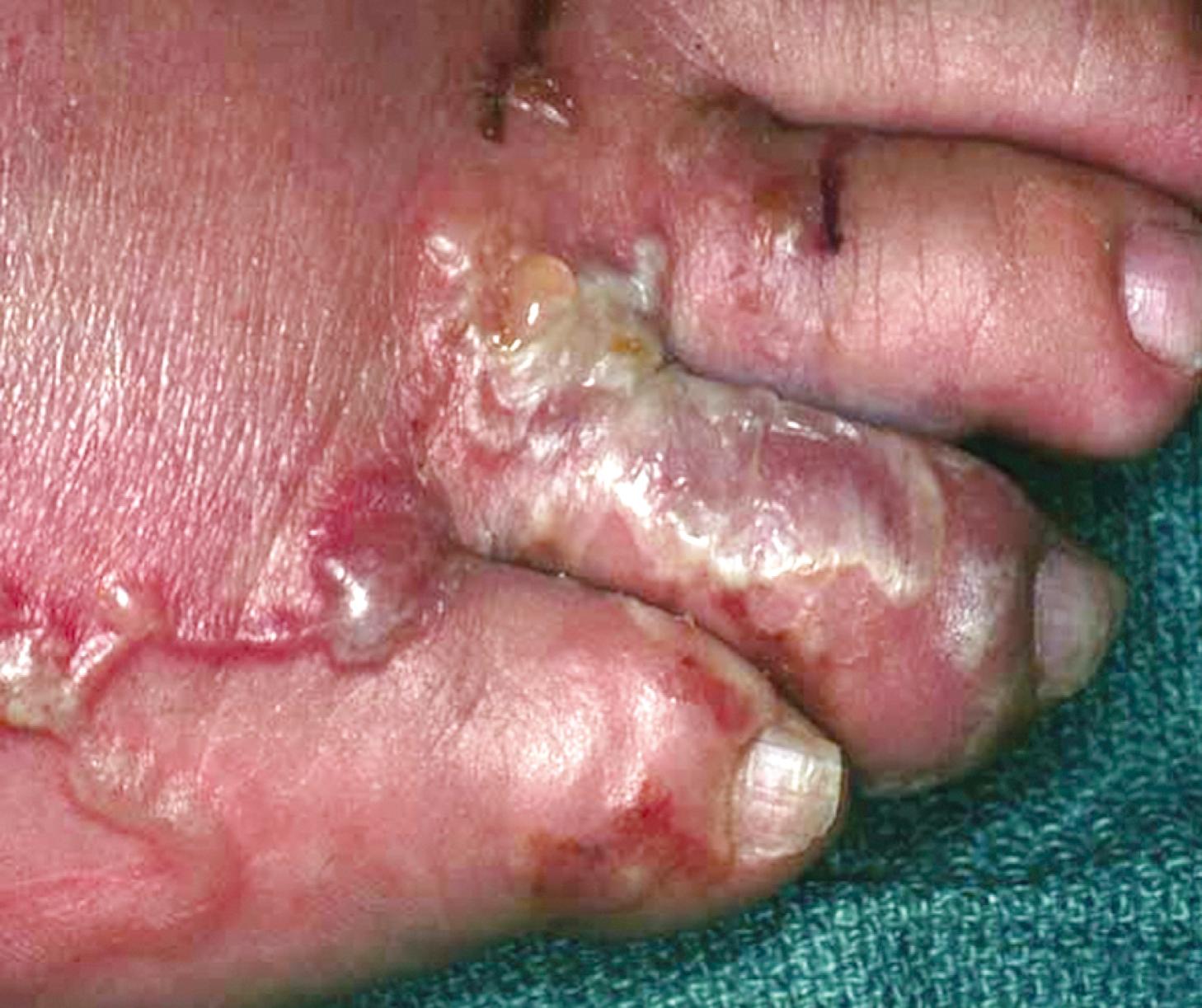
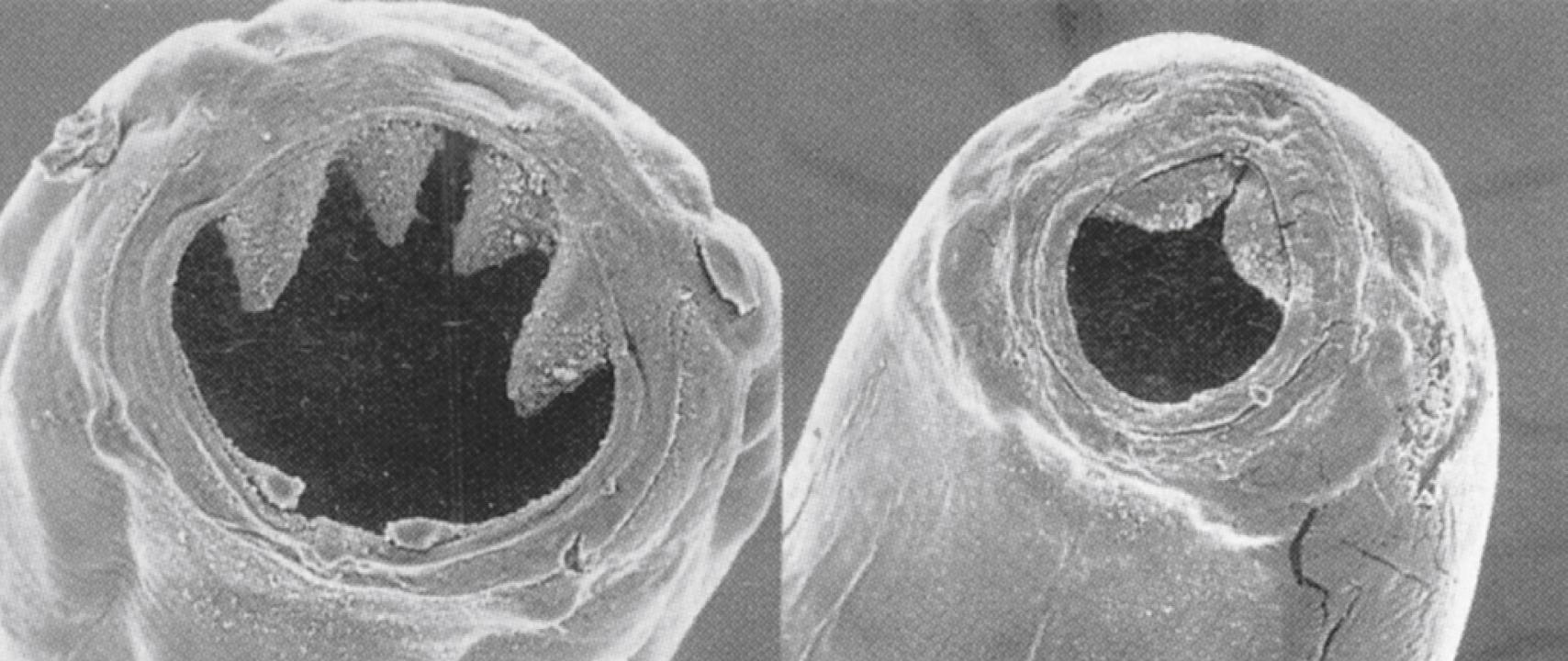
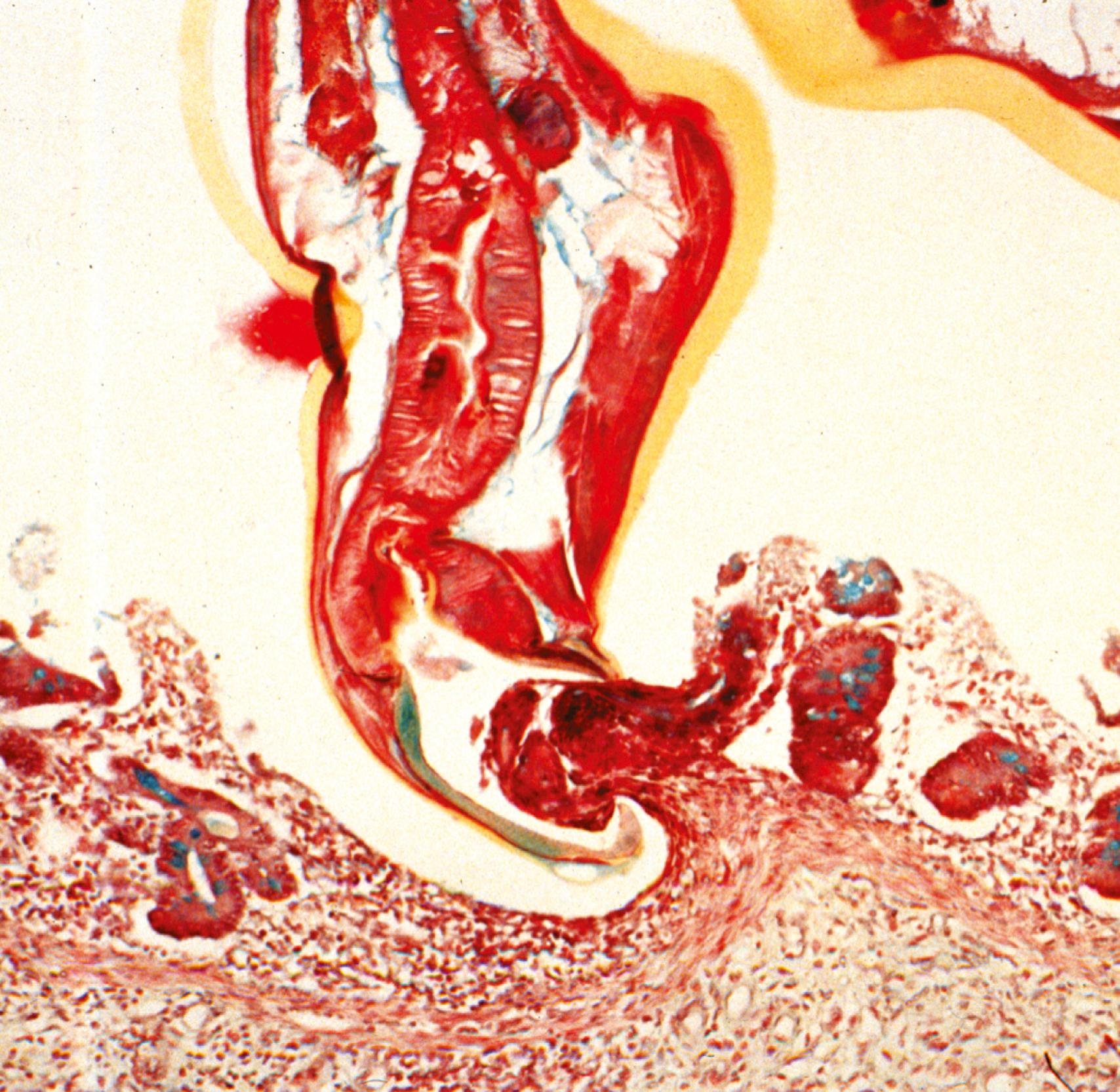
Light infestations with N. americanus and A. duodenale cause no symptoms. The major consequence of moderate and heavy hookworm infestation is iron deficiency. Adult worms feed on intestinal epithelial cells and blood. The closely related A. caninum (see later) secretes anticoagulant peptides that inhibit clotting factors and platelet aggregation, thereby preventing hemostasis and permitting the hematophagous parasites to feed on host blood. Intestinal blood loss is estimated to be 0.01 to 0.04 mL/day per adult N. americanus and 0.05 to 0.3 mL/day per adult A. duodenale. With a moderate number of worms, this blood loss becomes appreciable ( Table 114.1 ). Iron deficiency results when iron loss outstrips iron absorption. The average North American diet is high in iron so anemia might not develop, and men with a diet high in iron (more than 20 mg/day) can tolerate a burden of up to 800 adult hookworms without developing anemia.
| Condition | Iron Loss (mg/day) |
|---|---|
| Physiologic Loss | |
| Menstruation | 0.44 |
| Pregnancy | 2.14 |
| Lactation | 0.23 |
| Loss Due to Hookworm Infection | |
| N. americanus (60-200 worms) | 1.10 |
| A. duodenale (20-100 worms) | 2.30 |
∗ Losses shown are in addition to the basal iron loss of 0.72 mg/day.
Infestation with hookworm has been shown to modulate immune responses. Clinical trials are under way or have recently been completed to determine if subclinical infestation with hookworm inhibits immune-mediated disease such as Crohn disease, asthma, and celiac disease. Dose-ranging studies in healthy volunteers suggested that low-level (light) hookworm infestation is well tolerated. Treatment in asthma was well-tolerated but led to a nonsignificant reduction in airway responsiveness. Infection with N. americanus suppressed mucosal interferon (IFN)-γ and interleukin (IL)-17A production and in a small study of 12 patients with celiac disease, promoted tolerance to escalating gluten challenge.
Hookworms can be visible endoscopically ( Fig. 114.8 ), including by video capsule endoscopy, but diagnosis is made by identifying eggs on direct smears of formalin-fixed stool (see Fig. 114.3 ). Evaluation of 3 stool specimens obtained on separate days should permit diagnosis, but light infestations require concentration techniques. Recently, molecular techniques amplifying helminth DNA in stool specimens have demonstrated high sensitivity but may miss an infection if incorrect primers are selected. Eggs mature rapidly at room temperature and can hatch to release larvae. It is difficult to distinguish N. americanus eggs from those of A. duodenale simply by morphology.
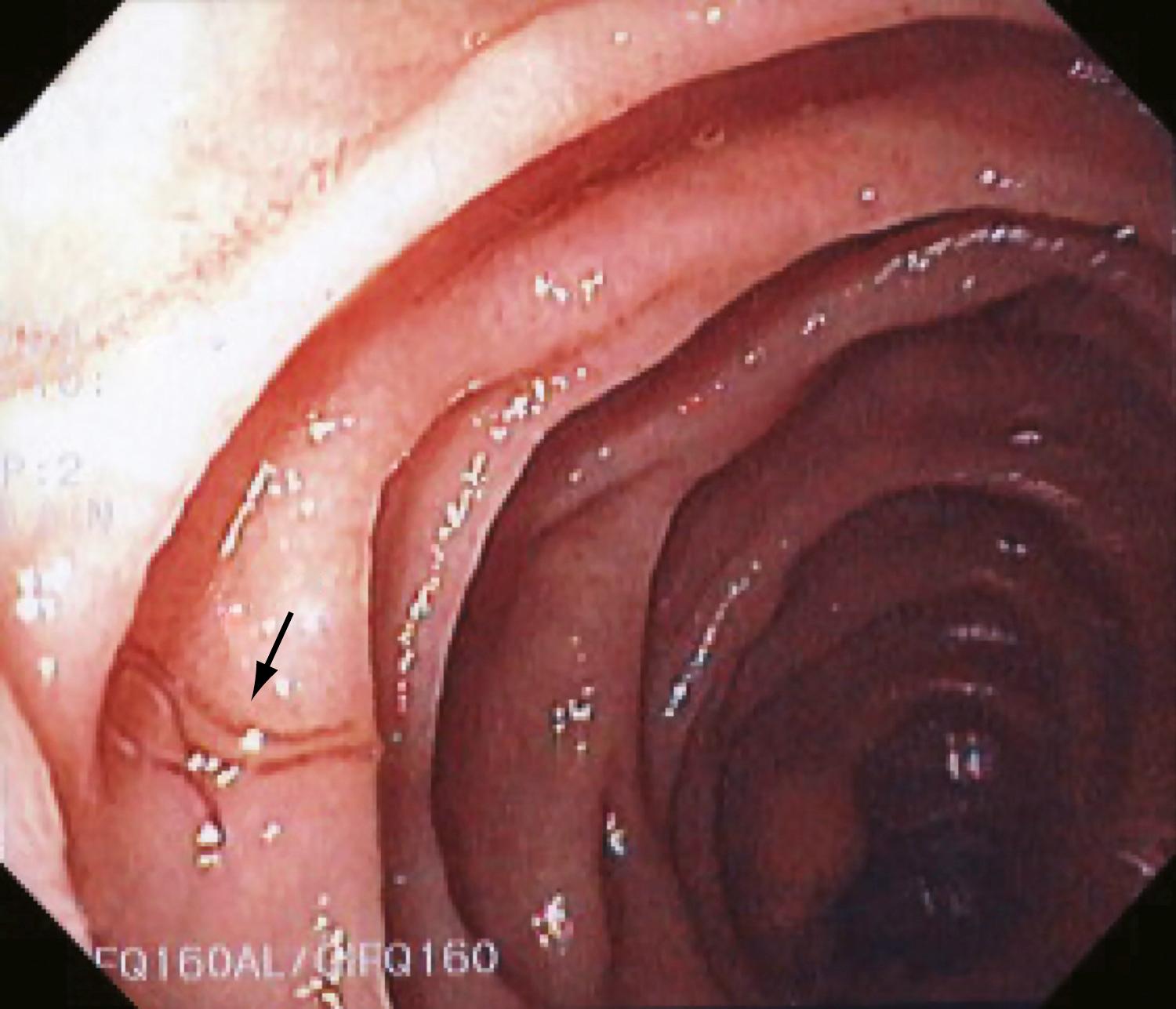
Albendazole 400 mg given orally as a single dose is adequate treatment for hookworm. Mebendazole 100 mg given orally twice daily for 3 days also is effective but not as well tolerated. A. duodenale larvae can remain in a dormant state for months before maturing and causing relapse, a situation that is treated with a repeat course of albendazole or mebendazole. Albendazole is an FDA pregnancy category C medication though a recent study showed no treatment-associated fetal or maternal adverse effects. There is a concerted effort to develop a vaccine for hookworm infections that would be used in endemic regions.
A. ceylanicum is unusual in that it can establish productive infection in a broad range of hosts. Although infections with human hookworm ( N. americanus and A. duodenale ) remain much more common, human infections with A. ceylanicum have been reported in West New Guinea, Philippines, Taiwan, Thailand, India, Laos, and Malaysia. A study performed in remote West Malaysia used molecular techniques to identify hookworm eggs passed in feces. They found that 9% of villagers and 92% of their pets were infected with hookworm. In the villagers, 80% of the samples could be analyzed and showed that 23.4% of people with hookworm carried A. ceylanicum either alone or with N. americanus co-infection. In their pets, 52% carried A. caninum and 46% carried A. ceylanicum suggesting that these animals could serve as reservoirs for the parasite . Light infections with A. ceylanicum can be asymptomatic but heavy infections can cause anemia.
A. ceylanicum matures to adulthood in the human host and probably shares similar pathophysiology with N. americanus and A. duodenale. Like those strictly human hookworms, adult A. ceylanicum can be observed endoscopically. Formal diagnosis is by identifying eggs in the stool, but the eggs of A. ceylanicum are not easily distinguished from those of N. americanus and A. duodenale without resorting to molecular techniques. Treatment is with oral albendazole 400 mg given as a single dose. If the patient has close contacts with pets, the pets should be tested and treated if positive.
A. caninum is a common hookworm of dogs and cats. It has worldwide distribution and is prevalent in the northern hemisphere. The parasite exists in areas with adequate sanitation because dogs and cats indiscriminately defecate in yards, parks, and sandboxes. The life cycle of A. caninum is similar to that of A. duodenale, and the worm can be acquired orally; however, A. caninum does not fully mature in the human host, so no eggs are produced making diagnosis difficult.
A. caninum is a well-recognized cause of cutaneous larva migrans, a distinctive serpiginous rash caused by an abortive migration of the parasite in an unsupportive host. A. caninum also can cause eosinophilic enteritis , although not all eosinophilic enteritis is caused by this parasite (see Chapter 30 ). Patients with eosinophilic enteritis from A. caninum often are dog owners and present with colicky mid-abdominal pain and peripheral eosinophilia, but they do not recall having cutaneous larva migrans . Intestinal biopsies show high numbers (>45/high-power field) of mucosal eosinophils, and eosinophilic inflammation is most prevalent in the distal small intestine. Unlike eosinophilic gastroenteritis, tissue eosinophilia is not present in the stomach. On endoscopy of the terminal ileum, patients may have scattered small superficial aphthous ulcers and mucosal hemorrhage. Serologic evidence suggests that A. caninum also may be a cause of abdominal pain without eosinophilia or eosinophilic enteritis.
Diagnosis of A. caninum infestation is difficult. The parasite never fully matures, does not lay eggs, and is hard to detect. Serologic tests for A. caninum are research tools not routinely available. Therefore, treatment for A. caninum is empirical.
Patients with distal small intestinal eosinophilic enteritis not attributable to another cause might benefit from empiric treatment for A. caninum . Albendazole 400 mg as a single oral dose or mebendazole 100 mg orally twice daily for 3 days is adequate to treat A. caninum infestation. Albendazole is a FDA pregnancy category C medication though a recent study showed no treatment-associated fetal or maternal adverse effects.
T. trichiura , commonly called whipworm, has worldwide distribution. People acquire Trichuris by ingesting embryonated parasite eggs. Most persons have no symptoms, although heavy infestations are associated with a dysentery-like syndrome. Treatment is mebendazole.
An estimated 800 million people harbor T. trichiura . It occurs in temperate and tropical countries and remains prevalent in areas with suboptimal sanitation. In one equatorial Cameroon province, 97% of the school-age children had T. trichiura. Whipworm eggs are sensitive to desiccation, so prevalence is low in desert climates.
T. trichiura has a simple life cycle. Colonization occurs by ingesting the parasite egg, each of which contains one developed larva. The eggs hatch in the intestine, and larvae migrate to the cecum, where they mature, mate, and lay eggs; this process takes about 8 to 12 weeks. Adult worms are approximately 3 cm long and have a thin tapered anterior region so that the worm resembles a whip ( Fig. 114.9 , ). A mature female worm lays about 20,000 eggs a day and can live for 3 years. Eggs are deposited with feces into the soil. Over the subsequent 2 to 6 weeks, one larva develops within each egg, but the egg is not infective until it has fully embryonated. Therefore, T. trichiura does not multiply in the host and is not directly transmitted to other persons.
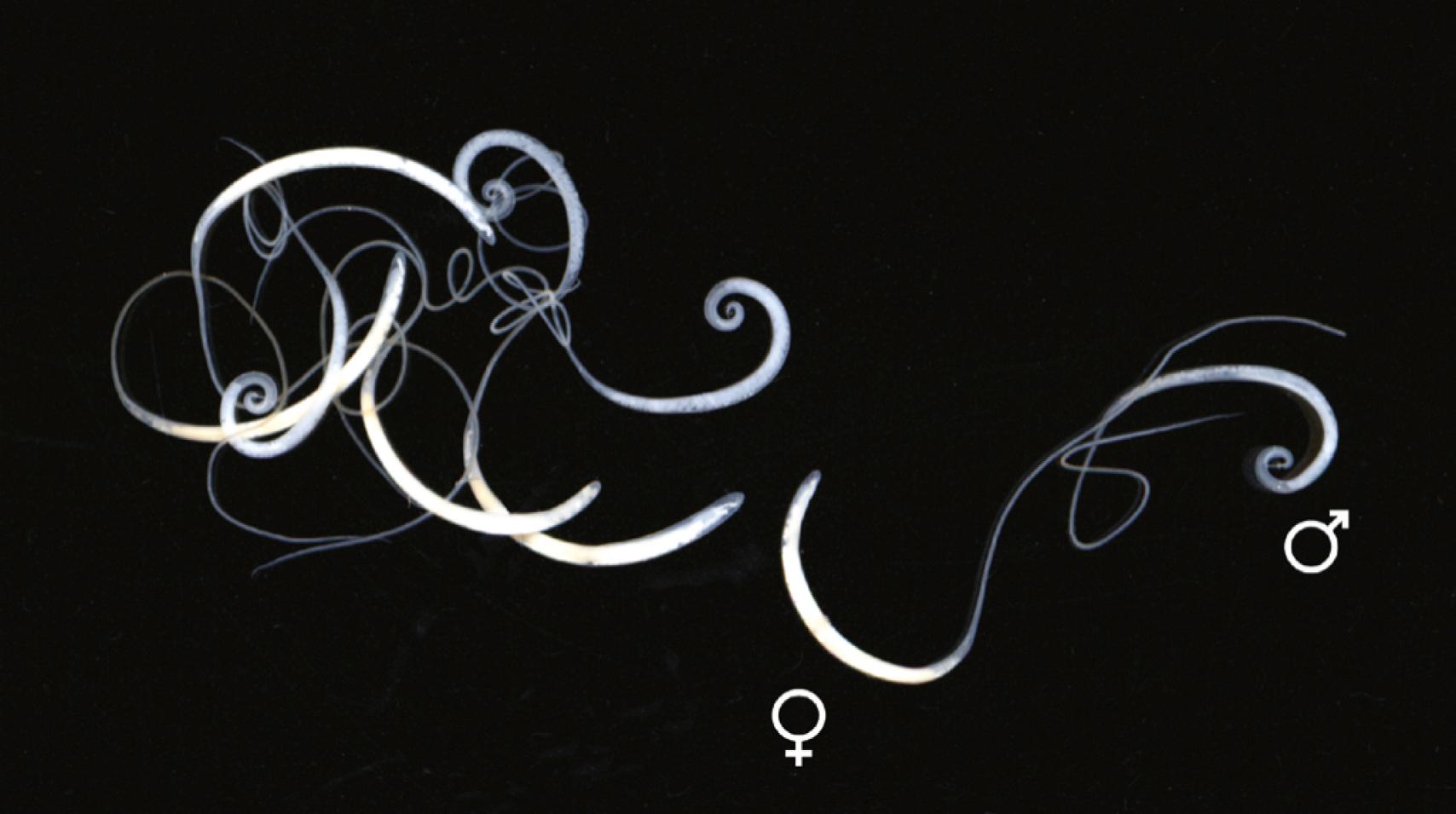
Become a Clinical Tree membership for Full access and enjoy Unlimited articles
If you are a member. Log in here